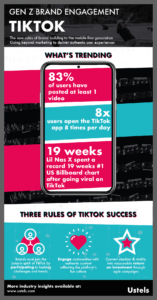BAT 2.0: ByteDance
Brand & Content Management Guide – Part II
This guide is part of the 2020 BAT Series. BAT – formerly consisting of Baidu, Alibaba and Tencent – continues to evolve and shape global technology trends. For the new decade, Baidu is out, ByteDance is in. BAT 2.0. ByteDance. Alibaba. Tencent. This changing of the guard reflects the culture of Chinese internet consumption. Mobile-first app ecosystems have fully replaced platforms previously described as ‘western-clones’. BAT 2.0 are leaders of innovation.
The Chinese digital landscape is hyper-fast and hyper-social, with familiar big names such as Google, Facebook, Amazon and Netflix excluded from the market. As such, China’s online world has diverged from the internet as we know it in the west – a ‘splinternet’. US tech giants now imitate features from their Chinese counterparts, with the two world’s rarely colliding. Western brands regularly clash with imitators in and disseminating from China. For success in China, brand owners must learn to navigate the online environment of the world’s largest manufacturer and exporter of pirated goods.
In 2020, BAT 2.0 command domestic digital dominance, and are increasingly reaching out from national constraints to exert influence over international digital culture. This guide provides an understanding of each BAT member, recognising the vibrant land of opportunity for commercialising brand assets whilst appreciating the flip side – the brand protection risks. Continue reading below to learn more about ByteDance – the company behind TikTok, the Gen Z killer app bridging the East-West divide.
ByteDance is much more than just TikTok and short videos for teens, the company is the mastermind behind one of the most integrated, iterative and transformative digital business models in the world.
As the digital economy becomes more mobile-led, the line between content, social media and ecommerce companies is increasingly vanishing. ByteDance exemplifies this shift. Whilst incumbent internet giants are evolving to the new environment, it can still be said that Alibaba is in the business of ecommerce and Tencent is a social media and gaming company. Both original BAT members have built significant infrastructure around their core, for example, Alibaba’s market leading cloud computing reduces the overheads of maintaining the largest ecommerce platform. Also, the capacity accommodates seasonal peaks, such as Double 11 day. Live streaming has been integrated into Taobao to guard against encroachment from social media companies in the realm of social-commerce. However, identifying the core of ByteDance is surprisingly difficult. Looking at star apps Jinri Toutiao and TikTok (known as Douyin in China) suggests the company is a content distributor, focusing on news aggregation and video content. It is tempting to categorise ByteDance as a content ecosystem and break down each service/app by content type, format, reach, monthly average users and demographics. But this approach fails to explain the rejection of more conventional business models, high turnover of product offerings, signalled ambitions, lack of brand consistency across products and how the company has been catapulted into mobile devices across China, India, Europe, the US and beyond. Before exploring the ByteDance business model in more depth, the inclusion over original BAT member Baidu must be justified.
ByteDance > Baidu
Baidu is still the most visited website in China, and fourth most visited in the world (according to SimilarWeb rankings) – the go-to search engine for Chinese language content. Rival search engines have made some inroads into Baidu’s lead, however, this does not motivate Baidu’s displacement from the BAT trio. Relegation should not come as a surprise, as stated in Part I of BAT Series 2019:
“Out of the big three, Baidu has struggled the most in recent years. Famous for search engine dominance, Baidu failed to adapt to the shift towards the mobile era. With a poor acquisitions record, Baidu has been left trailing rivals, now forming a big two. Alibaba and Tencent are seemingly more focused on upstart domestic competition such as ByteDance or international rivals in strategic growth markets. The failure of Baidu to make a success of their online-to-offline strategy has forced the company to double down on an area of relative strength – AI. Baidu joined the Partnership on AI, which includes Google, Microsoft, Apple, Amazon, Facebook and co. to coordinate AI development best practices. AI technology is central to Baidu’s future, investing heavily in natural language processing, image recognition and self-driving cars.”
Furthermore, in Chapter 12 – Mobile Environment of Digital Brand Protection:
“China, the largest producer of counterfeit items in the world, has seen a more pronounced shift towards a mobile-centric digital society. China’s tech scene was previously dominated by Baidu, Alibaba and Tencent, collectively referred to as BAT. Not only did these companies develop the most innovative products and services, but they would snap up any new tech upstart which threatened their grip. Out of the three, Baidu has struggled the most in recent years – due largely by a delayed shift towards the mobile environment. Baidu, still China’s largest search engine, failed to recognise more users were searching on mobile devices, or within app ecosystems which locked-out Baidu. Most of Baidu’s search engine revenue is generated from mobile devices, however, user culture developed before the company adapted. The digital sphere is dominated by app ecosystems and platforms from BAT 2.0 – ByteDance (parent of Douyin, TikTok and Toutiao), Alibaba and Tencent.”
And again in October 2019 we stated “ByteDance has already displaced Baidu into forming BAT 2.0” when discussing IPO speculation.
As far back as late 2016, and certainly by 2017 rightsholders had started to shift brand protection resources away from Baidu, into more profitable, high-growth areas such as Weidian, Pinduoduo and Douyin. This is not to say Baidu can or should be ignored in terms of content distribution, marketing or brand protection.
Content distribution
iQiyi, referred to as the Netflix of China. IQiyi has a working partnership with Netflix to distribute content and is the leading video streaming platform in China, with a two-pronged operating model. iQiyi offers a free version which runs ads to generate revenue or a subscription model which removes ads. The emphasis has been trying to shift customers to paying a subscription fee, generating easy to predict cashflows which can then be re-invested into production of high quality, exclusive content. iQiyi has around 100 million paying subscribers, with strong growth driven by exclusive content and acquisitions of rights from popular international shows i.e. trendy South Korean TV dramas.
Marketing
Brand Zone is a vital feature enabling brands in the delivery of highly interactive ads in prominent search engine result page real estate. Given 75% of the SERP is used for ads and Baidu owned properties, such as Baike and Zhidao, Brand Zone is one of the few ways of ensuring an engaging user experience for those interested in the brand. The ads can include images, video content, social media feeds, music and carousel product displays, all without leaving the SERP. Once all brand names are registered with Baidu it becomes easy to monitor and prevent infringements within Brand Zone.
Brand protection
Organic results can be used to detect sources of infringements; the onus remains firmly on the side of rightsholders to monitor, detect and enforce infringements. The best approach is to remove infringements within organic results from the source, creating clean SERP dedicated to genuine products and legitimate distribution channels. Infringing paid ads are a relatively low priority for most brand owners, with most having significantly reduced enforcement budget for Baidu paid ads over the past 2-3 years. Baidu is also the go-to for investigators when searching for personal identifying information (PII) about a Chinese target.
Baidu is still relevant, with the resources to mount a Microsoft-esque reinvention. However, in China, the search engine model itself is declining. Which is why Baidu is not being replaced by a larger or more modern search engine, but a mobile-first model representing the preference for app platforms and ecosystems.
But Why ByteDance?
The ousting of Baidu has been justified. But does ByteDance deserve the place at the BAT table? Market analysts value ByteDance as the second largest tech unicorn, at $75-80 billion, only behind Ant Financial, Alibaba’s financial services spin-off which includes Alipay. This valuation is higher than Baidu’s, and 10x that of Snapchat. However, it is significantly behind BAT stalwarts Alibaba and Tencent.
Moving away from stock tickers back to product. ByteDance has a large portfolio of apps within and outside of China, using a sister apps model to serve the two areas. For example, Douyin sister app is TikTok, both have the same logo and the apps operate in essentially the same manner. Huoshan’s sister app is Vigo, very similar to Douyin/TikTok, but tends to favour a demographic from lower tier cities and rural areas. In January 2020 ByteDance announced greater integration between Douyin and Huoshan, with the stated aim of increasing reach for creators.
Toutiao as the company’s first killer app acts as an incubator for new features which are often spun out into an independent app, only for the content to then be integrated with Toutiao to boost functionality in both apps. This includes several attempts to move into ecommerce, blending shopping experiences with content consumption. So far Toutiao’s attempts at ecommerce have not been a break out success, but it is foreseeable ByteDance will continue to iterate until they find a formula which goes viral, launching the company as an upstart competitor to Alibaba, JD and Pinduoduo. Toutiao’s sister app TopBuzz is less of a sister and more of a cousin. Toutiao and TopBuzz have different branding, although the apps operate using the same business model. TopBuzz has not an international success in the manner of TikTok, but does have a growing userbase and healthy number of creators contributing to the platform. This space is very competitive in the west, including rivals such as Google News and Medium, the TopBuzz model sits somewhere between these two platforms as a news aggregator and also a publishing platform for content creators. It is likely growth will come from international markets outside the US by focusing on highly localised content in multiple languages. News Republic operates in a similar manner and is another international news aggregator platform. This brand was purchased but continues to operate independently, positioned as a more upmarket news source than TopBuzz.
Apps across the entire ByteDance ecosystem integrate, with video apps being developed to provide original content for the news aggregation apps. Marketing campaigns can span multiple apps, depending on the reach requirements of the buyer. The ecosystem benefits from the purchasing of technology which is implemented into the apps. The popular apps musical.ly and Flipgram were purchased for the added end-user functionality. Musical.ly was fully integrated into TikTok, including the large library of licensed music, whereas Flipgram still operates as an independent app.
Before turning to the same criteria applied to Baidu above, we will give the final word to scathing TikTok critic Mark Zuckerberg on why ByteDance is worthy of the BAT moniker:
Content distribution
By the end of 2018 ByteDance had over a billion monthly active users across all products worldwide. Mid-2019 the reported figure jumped to 1.5 billion, with a daily active user figure of 700 million – reflecting high user stickiness. The majority of users are from star apps including Toutiao, Douyin/TikTok, Huoshan and Xigua. Chinese and regional products have content stored locally. For example, Douyin and TikTok are essentially the same app, however, Douyin is only available in mainland China. Douyin data is stored in China, compliant with Chinese content governance regulation. A Douyin user cannot view videos from a TikToker; unless the video was uploaded to both platforms independently, many politically motivated content creators are doing so. The separation of the ecosystems has led to cultural divergence between Douyin and TikTok – a trend replicated across the portfolio of sister apps.
The Helo app is headquartered in India, with ByteDance investing heavily into building datacentres to keep up with demand. This approach promotes the development of localised content for a local audience, including language specific content. ByteDance’s success in connecting with internet users in lower tier cities and rural areas owes much to programmatic delivery of highly localised content.
Across all products content creators and partners are aggressively pursued. For example, TopBuzz, a westernised version of the Toutiao model partners with major media outlets including Bloomberg, Reuters, The Guardian, Vice, Time, BuzzFeed, CNN etc. However, most of the content is produced by individual publishers i.e. content creators. TopBuzz scoured user-generated content platforms blanketing creators with requests to upload content directly to TopBuzz. YouTube, Facebook and Medium were particularly targeted to recruit creators, promising higher revenue than offered by other platforms.
This approach taps into the large online content creator community, providing an additional revenue source, especially important for smaller creators struggling to build a following on mature platforms. Tools for syncing accounts or uploading content form another platform reduce friction, providing the ability for creators to ‘test the waters’. New creators are pushed by the platform, tapping into the dopamine release to convert a re-uploader of YouTube content into a producer of original content for the platform. Why get 200 views on Instagram Stories when you could get 50k views on TikTok. Monetisation is mainly indirect from video platforms such as Douyin and TikTok, with influencers relying on commercialising their following, utilising integrated ecommerce features and/or donations from followers. Whereas the news aggregation platforms are littered with digital advertisements, weaved between reputable reporting, endless clickbait and user-generated content. Monetisation of traffic enables content creators to earn income directly from uploading. And the earnings are immediate, unlike YouTube which requires 1,000 subscribers and 4,000 hours of viewed content before monetisation can be enabled. The instant rush of success creators experience and hyper-fast, disposable nature of the content entices them into accelerating content production. A digital advertising goldmine.
Whilst claims of clickbait or inappropriate content are rife across all ByteDance products, the company uses highly sophisticated algorithms to programmatically distribute content. Users tend to find the products quickly adjust to preferences, including content type by time of day. For example, a user may be pushed more serious news in the morning and light-hearted videos in the evening. Whereas Facebook and Twitter obfuscate content moderation policies behind the guise of free speech, ByteDance is far more aggressive in removing content. Partly a reaction to having a number of products outright banned by the Chinese government. Inappropriate content cover violence, nudity and anything which goes against communist ideals; the last category being a catch-all bucket for the government. Beyond China ByteDance has also experienced content moderation growing pains, including in the US and most notably India. The company’s response in all major scandals has been to quickly accede to the respective government’s demands and employ sways of local content moderators. Radically different from the Zuckerberg/Dorsey approach of firing up their media-machines to combat any criticism, which mainly serves to perpetuate scandals and heat up political debates. ByteDance’s trigger finger approach to content moderation has created controversy, including accusations of suppressing content from Hong Kong protesters and marginalised communities in China and India.
Inevitably, all platforms facilitating user uploads face abuse, regardless of their approach to content governance. Typically, video platforms are accused of enabling copyright infringement. A lack of mass-scale copyright infringement across Douyin/TikTok and Huoshan is an inherent strength of the short-form video format; combined with the huge library of licensed music content creators have access to. This represents a significant financial saving for the company in not having to invest the amount Youku, YouTube or Facebook does in developing automation tools to support digital rights management for copyright holders.
Although consumption of short-video content is the fastest-growing segment of streaming market in China, it must be noted that ByteDance does not have a direct competitor to iQiyi, Youku or Tencent Video. Xigua Video was created to fill the gap, removing the video length restrictions as imposed by Douyin and Huoshan. However, Xigua hosts relatively shorter videos, averaging around 3-6 minutes which is mainly user-generated content and without a significant library of licensed content. The big three long-form video platforms have broadcast agreements with major sports league and invest heavily into producing hit series and films. This business model is supported by ad and subscription revenue, whereas Xigua relies solely on ads. The gap Xigua fills is supporting Toutiao with longer video content without changing the core of Douyin or Huoshan.
Marketing
Digital advertising has been an easy sell for ByteDance, surging past Baidu into second place, only behind market leader Alibaba. ByteDance’s market share of digital advertising is 23%, with BAT 2.0 collectively accounting for 70% of the market. This goes up to 87% if also including Baidu into the mix. This distribution of digital ad spend is comparatively more concentrated than the US. Google (including YouTube) and Facebook (including Instagram) account for approximately 60%, with all other companies with less than 10% market share. These figures highlight the relative relevancy of the search engine in China and the US, whereby Google commands more than double the digital ad revenue market share than Baidu. The figures also highlight the success of ByteDance of breaking into the competitive digital ad market, especially given out of the major economies, China has the highest proportion of ad spend going into digital channels. Meaning, ad spend into ByteDance is largely coming from spend previously going to Alibaba, Baidu or Tencent. However, put into context, the US digital ad market is 4x that of China, and as of yet ByteDance has failed to make the same impact in the US ad market. Digital ad revenue in China benefits from an app ecosystem with multiple entry points supported two star apps – Douyin and Toutiao. Douyin’s westernised sister TikTok has been a huge success in the US, Toutiao’s international cousin TopBuzz, whilst popular, has not been a runaway success. Advertising is far more prevalent on Toutiao and with a greater range of ad options to purchase compared to Douyin, which only facilitates video content. Without a successful US Toutiao-style app it is hard to see ByteDance challenging Google and Facebook in terms of ad spend in the west. To note, advertisers pay more for a US audience compared to the equivalent European audience.
Outside of the US and Europe, ByteDance has two other important digital ad revenue streams with significant potential for growth. Firstly, in India, where TikTok is hugely popular and the company has invested in developing localised content in a range of languages for maximum reach and segmentation. The Helo app gained over 50 million monthly average users a year on from launch. The app is available in 14 languages, including Hindi and Tamil. Facebook has over around 240 million monthly average users and has more Facebook users than any other nation. However, ByteDance’s strategy encourages the creation of local content, which better serves the country. India could be a key battleground to monitor ByteDance vs Facebook. Secondly, countries which a large population of Chinese speakers, specifically the high-growth economies of the ASEAN region. This market is another with a large Facebook user base, and viewed as a growth market. ByteDance benefits from the Chinese cultural influence on a number of countries currently in the top 10 list of users by country including Indonesia (#3), Philippines (#6), Vietnam (#7) and Thailand (#8). The comparisons with Facebook is only in terms of creating an ecosystem which provides a userbase which can be effectively monetised through digital advertising. There is no good western analogy for the ByteDance business model. Toutiao is often described as ‘like Facebook news feed without any other features’. Whilst this over simplifies Toutiao, it does highlight ByteDance’s content-centric model rather than social engagement. But advertisers have found ByteDance apps are more conducive to marketing campaigns than rivals such as Tencent’s WeChat or Snapchat.
Brand Protection
In May 2019 World Trademark Review reported on the severe lack of awareness surrounding brand protection issues on TikTok. The article followed the INTA Annual Meeting, where it was apparent how much slower the brand protection sector is in comparison to marketing and digital culture. The article states “At least two representatives from IP monitoring firms weren’t even aware of TikTok”. In a follow up piece for World Trademark Review we discussed some reasons why brand protection is sluggish in respond emerging trends such as the rapid rise of TikTok. Partially it is caused by a general lack of awareness about the Chinese digital environment. Also, a general lack of awareness about non-traditional ecommerce platforms, even those which are being used by the community for ecommerce. Although, most IP monitoring firms were also shocked to hear of Pinduoduo for the first time when Pinduoduo went public in the US. The Pinduoduo case demonstrates the overlooking of mobile-first platforms. Western service providers still operate with a ‘desktop mindset’. Digital Brand Protection states “Out of all the core areas of brand piracy, mobile apps are without doubt given the least attention. There are numerous reasons for this disparity ranging from the technical challenges in monitoring apps to a lack of cultural understanding of the mobile environment. IPR infringements from mobile apps are often unmonitored, with the activity persisting over years without the rightsholder identifying the issue and therefore unable to take effective enforcement action….. A re-evaluation of any brand protection strategy which does not emphasise mobile apps should be undertaken.” Cyber-investigators too under-utilise mobile apps “mobile apps [are] an underdeveloped area in within cyber-investigations. Difficulties in searching for content, availability of PII on mobile platforms and the ephemeral nature of content builds barriers for investigators in capturing data.” Therefore, ByteDance being a Chinese company operating a non-traditional ecosystem of apps which are seemingly not commerce-centric with a mobile-first strategy and a young target audience had almost no chance of being on the radar for most vendors. Meanwhile, marketing teams had been reaping the benefits of paying attention to digital culture – the May WTR article states the NBA already amassed over four million followers, half a year later they have over 7 million followers.
The main brand risk from ByteDance’s news aggregation apps is the presence of reputationally damaging fake news. Fortunately fake news is swiftly removed upon notice, or proactively by the company’s AI-powered content monitoring software. The various short-form video apps present numerous brand piracy risk through the tactics employed by infringers.
Douyin influencers are being given the opportunity to utilise a feature which connects their account with a Taobao store. This feature can be used for an influencer’s own store, or enabling influencers to leverage their following with a third-party rightsholder to deliver promotional content. Opening ecommerce features to Taobao stores presents an obvious risk of counterfeits entering the Douyin platform, as any experienced investigator will attest to. Taobao sellers are often knowledgeable in exploiting new digital distribution channels and avoiding enforcement efforts.
Douyin users without ecommerce features employ another common tactic; adverts showcasing counterfeits combined with a WeChat ID. Potential customers are directed to WeChat to discuss and complete the transaction. Chinese consumers are very familiar and comfortable with this process. WeChat marketing is highly competitive, including strong presence of rightsholders, therefore counterfeiters are turning to Douyin to attract consumers to their WeChat, either by conducting the transaction through chat features and WeChat Pay, or directing the consumer to their WeChat Store for conversion.
Digital ecommerce giants in China are heavily investing into connecting online and offline experiences. Physical stores are not oblivious to this trend and are using digital channels to drive footfall to their store. Infringers are appropriating the reach of Douyin by using the app as an interactive online catalogue to promote counterfeits. Customers of counterfeit items in China often want to inspect the quality before purchase. Retailers openly advertise their store and counterfeit items in relative impunity compared with the heavily regulated ecommerce platforms such as Taobao and JD.com. Addresses are normally easy to obtain either directly from the videos of the infringer or through communication handled either in comments or connecting through WeChat.
A worrying trend of factories directly advertising on Douyin has started to emerge. Fortunately, this tactic provides an investigator with all the information necessary to detect infringements, arrange a test purchase and create a case for local law enforcement to action. The factories are openly including their registration license in videos or profile bio. Many factories are using their WeChat ID or phone number for their Douyin ID, greatly reducing the investigatory burden. Reporting a factory producing counterfeits should be done when the case file shows the revenue stream is significant enough to meet the minimum criminal liability threshold.
Hashtags are vital to discovery on TikTok and Douyin. With many rightsholders ignoring the apps, especially western companies, infringers are freely accessing branded hashtags to advertise knockoffs. The influence of TikTok on purchasing decisions is still undervalued by many brands, creating space for infringers to exploit within the digital supply chain. Some rightsholders on the other hand have recognised the potential of the app to engage a younger demographic with campaigns designed to build awareness and drive sales. Rightsholders utilising the platform have had success in keeping key branded terms clean of counterfeits, notably on Douyin. However, the lower awareness of rightsholders outside of China has led to relatively less success on TikTok.
TikTok and Douyin users can take advantage of the live stream function, which bypasses the video clip time limit. Live streams are very popular on both apps and streaming within ecommerce is increasingly popular in China more generally. Counterfeiters on TikTok and Douyin use influencers and live streaming to quickly generate large volumes of traffic to their sales channel. With live streaming, traditional brand protection tactics of relying on automated scraping tools to collect data which is then reviewed before enforcement action is taken becomes obsolete. Live streaming requires live monitoring by investigators, to detect the infringement when valuable enforcement action can still be taken. Smart infringers will typically remove any traces of infringing content from the platform used to complete the transaction once the live stream traffic spike fades. This approach mirrors tactics employed by infringers on Instagram, whereby they build a strong organic following, then use short ad campaigns featuring knockoffs to drive traffic to webstores. The shortened timeframe the knockoffs are publicly available significantly reduces the chances of detection and removal. With high volume sale periods such as Double 11 in China and Black Friday in the US condensing significant chunks of ecommerce activity into a few days, the potential loss of sales from these short bursts of brand piracy represents a substantial risk.





